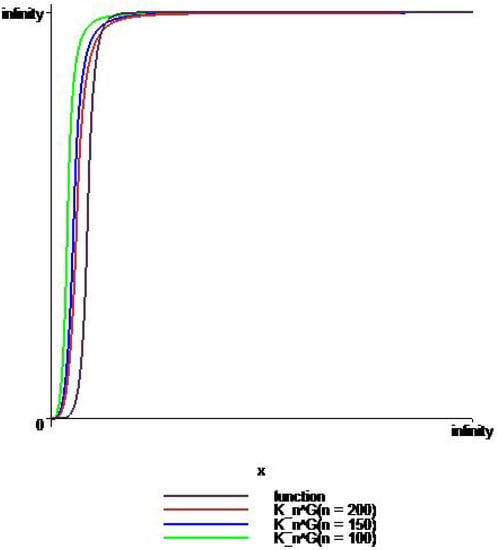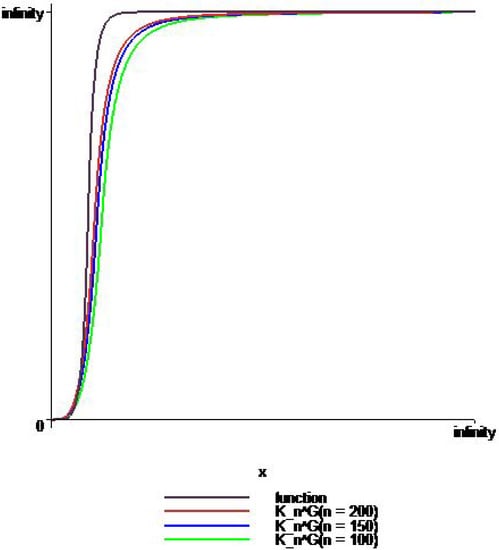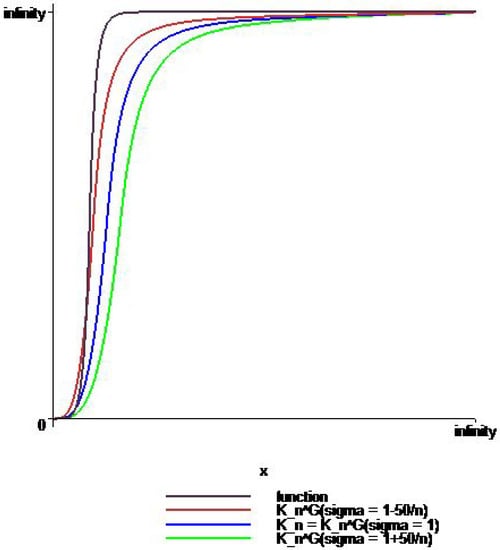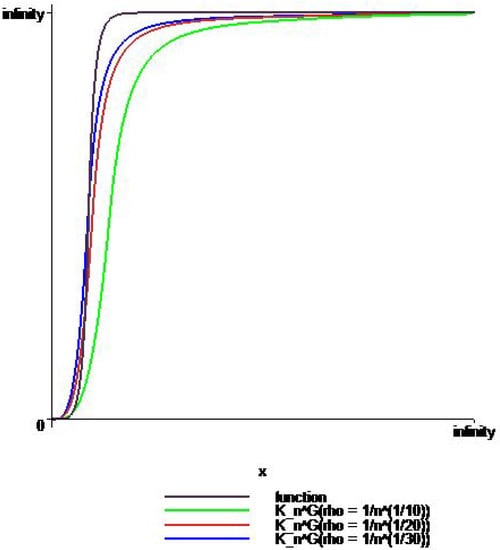Abstract
We introduce a new Kantorovich-type rational operator. We investigate inequalities estimating its rates of convergence in view of the modulus of continuity and the Lipschitz-type functions. Moreover, we present graphical comparisons exemplifying concretely its better approximation for a certain function. The results of the paper are crucial by means of possessing at least better approximation results than an existing Kantorovich-type rational function.
Keywords:
approximation of positive operators; rate of convergence; Kantorovich-type operator; rational function MSC:
41A25; 41A36
1. Introduction
In 1975, Balázs [1] introduced the following rational function for any real function v on and sequences of real numbers and such that by
and he investigated its approximation properties by choosing for functions such that for some In 1985, Balázs and Szabados [2] improved its approximation properties under more restrictive cases such that , , . Moreover, Balázs [3] studied these operators on all the real axis. Totik [4] investigated the saturation properties of Balázs–Szabados operators, and Abel and Veccia [5] obtained a Voronovskaja type result. Agratini [6] studied Bernstein type rational functions by choosing a strictly decreasing positive real sequence such that as follows:
where v is continuous on satisfying a certain growing condition.
The Kantorovich extension of the operator defined by (1) was given by Agratini [7] in 2001 by
where , , v is a measurable function on and bounded on each compact subinterval of , is a real sequence for . In [8], Agratini studied the Kantorovich operator defined by (3) under the condition such that , . For some other Kantorovich-type rational operators, one can see the references [9,10,11,12,13].
Recently, a new generalized Bernstein-type rational function [14] has been introduced by
where , , v is a continuous function on , , , and are non-negative sequences of real numbers, satisfying , and its approximation properties have been investigated under the following conditions:
The operator is reducible to (1) and (2) when , and and it has at least better approximation than the operator defined by (1) (see [14]).
In this paper, we initially introduce a Kantorovich-type operator of the generalized rational function defined by (4), which is a generalization of the operator defined by (3). Secondly, we investigate its Korovkin-type local and global approximation properties. Lastly, we present some graphical comparisons of the new Kantorovich-type rational operator with the operator defined by (3). The results of the paper is crucial by means of possessing at least better approximation results than those existing for the Kantorovich-type operator defined by (3).
2. Definition of Kantorovich-Type Operator
In this part, we constitute a new Kantorovich-type operator including the operator defined by (3), and we present some auxiliary results.
Definition 1.
Let v be a real-valued measurable function on and bounded on each compact subinterval of . A new Kantorovich-type rational operator of the generalized rational function given in (4) is defined by
where , , , and are non-negative sequences of real numbers such that , satisfying (5). The operator is a linear positive operator, satisfying the property:
Lemma 1.
We have the following results for the operator :
3. A Korovkin-Type Approximation Result
In this section, we give local and global approximation results for the Kantorovich-type operator defined by (6).
Theorem 1.
Let , , be Kantorovich-type operator defined by (6). If , then converges to v uniformly on , , for each .
4. Rates of Convergence
Now, we estimate the rate of convergence by means of the first and second modulus of continuity and Lipschitz-type functions.
By is denoted the space of real-valued continuous and bounded functions on .
For any , the modulus of continuity of is defined as
which satisfies the following inequality:
for , and , when v is uniformly continuous [16].
Theorem 2.
If , then
where
Proof.
Let . By (17), we have
Applying the operator to (19), and using the Cauchy–Schwarz inequality, we obtain
By replacing , the proof is completed. □
For , the Petree’s K-functional is defined as
where is the supremum norm on and
We have the following inequality (see p. 192 in [17]):
where
Theorem 3.
Proof.
Let . For any , by Langrange form of Taylor theorem, we can write
where is the remainder term for some real number such that and .
Applying the operator to (25), we obtain
In (26), by using the Cauchy–Schwarz inequality, we get
For , we can write
Let and . For , a class of Lipschitz-type functions denoted by is defined as follows:
where , , is a constant, and is the closure of A in .
Theorem 4.
If , then we have the following inequality:
where , and , is given as in (18), and is a constant depending on v.
Proof.
Let and . For , we can write
In (31), from Hölder’s inequality for and such that , we obtain
which completes the proof. □
Remark 1.
In Theorems 2–4, is depend on x and choosing of , , and . , , and must be non-negative real sequences satisfying . Otherwise, these theorems become invalid. For example, if and , then . This is not only possible condition such that .
5. Some Comparisons
In this section, we present an example demonstrating concretely the approximation of the operator
Example 1.




Let v be a real-valued function on such that .
In Figure 1, we compare the approximation of to on for increasing value of n by choosing such that , i.e., and . We see that the approximation of the operator becomes better for the increasing value of n.

Figure 1.
Approximation by (orange), (blue), and (green) to (violet) on for , such that , i.e., and .
In Figure 2, we compare the approximation of to on for increasing value of n by choosing , such that ; i.e., and . Similarly, we see that the approximation of the operator becomes better for increasing value of n.

Figure 2.
Approximation by (orange), (blue), and (green) to (violet) on for , such that , i.e., and .
In Figure 3, we compare the approximation of , and to on by choosing , such that , i.e., , and , and , which satisfies the opportunity of comparison the operator with the operator defined by (3). We can see that has at least better approximation than

Figure 3.
Comparison of the approximations by (orange), (blue), and (green) to (violet) on .
In Figure 4, we compare the approximation of , , and to on by choosing , , , and , such that for . We have better approximation for than the others.

Figure 4.
Comparison of the approximations by (blue), (orange) and (green) to (violet) on .
6. Conclusions
In this study, we have introduced a new Kantorovich-type rational operator reducible to the Kantorovich-type rational operator defined by (3), and we have been obtained its rates of convergence. The exemplifying application of this operator has demonstrated that the new Kantorovich-type rational operator has at least better approximating results depending on choice of the sequences , , and the fuction v than the existing Kantorovich-type operator defined by (3) (see Figure 3). Obtainig a general result for the better approximation for the new Kantorovich-type rational operator and the Kantorovich-type rational operator defined by (3) is an open problem for future work motivated by this study.
Funding
This research received no external funding.
Institutional Review Board Statement
Not applicable.
Informed Consent Statement
Not applicable.
Data Availability Statement
All datas of this article are included in the text.
Acknowledgments
The author is grateful to all the reviewers contributed to the best presentation of the paper with their valuable comments.
Conflicts of Interest
The author declares no conflict of interest.
References
- Balázs, K. Approximation by Bernstein type rational functions. Acta Math. Hung. 1975, 26, 123–134. [Google Scholar] [CrossRef]
- Balázs, K.; Szabados, J. Approximation by Bernstein type rational functions II. Acta Math. Hung. 1982, 40, 331–337. [Google Scholar] [CrossRef]
- Balázs, K. Approximation by Bernstein type rational functions on the real axis. Acta Math. Hung. 1985, 46, 195–204. [Google Scholar] [CrossRef]
- Totik, V. Saturation for Bernstein type rational functions. Acta Math. Hung. 1984, 43, 219–250. [Google Scholar] [CrossRef]
- Abel, U.; Vecchia, B.D. Asymptotic approximation by the operators of K. Balázs and Szabados. Acta Sci. Math. (Szeged) 2000, 66, 137–145. [Google Scholar]
- Agratini, O. On a class of Bernstein-type rational functions. Numer. Funct. Anal. Optim. 2020, 41, 483–494. [Google Scholar] [CrossRef]
- Agratini, O. Approximation process on Kantorovich type. Miskolc Math. Notes 2001, 2, 3–10. [Google Scholar] [CrossRef]
- Agratini, O. On approximation properties Balázs-Szabados operators and their Kantorovich extension. Korean J. Comput. Appl. Math. 2002, 9, 361–372. [Google Scholar] [CrossRef]
- Gupta, V.; İspir, N. On Bézier variant of generalized Kantorovich type Balázs operators. Appl. Math. Lett. 2005, 18, 1053–1061. [Google Scholar] [CrossRef][Green Version]
- Gupta, V.; Lupaş, A. On the rate of approximation for the Bézier variant of Kantorovich-Balázs operators. Gen. Math. 2004, 1, 3–18. [Google Scholar] [CrossRef]
- Gupta, V.; Zeng, X.M. Rate of approximation for the Bézier variant of Balázs Kantorovich operators. Math. Slovaca 2007, 57, 349–358. [Google Scholar] [CrossRef]
- Özkan, E.Y. Approximation properties of Kantorovich type q-Balázs-Szabados operators. Demonstr. Math. 2019, 52, 10–19. [Google Scholar] [CrossRef]
- Hamal, H.; Sabancıgil, P. Some approximation properties of new Kantorovich type q-analogue of Balázs-Szabados operators. J. Inequal. Appl. 2020, 2020, 159. [Google Scholar] [CrossRef]
- Özkan, E.Y.; Aksoy, G. On a new generalization of Bernstein-type rational functions and its approximation. Mathematics 2022, 10, 973. [Google Scholar] [CrossRef]
- Korovkin, P.P. On convergence of linear positive operators in the space of continuous functions. Dokl. Akad. Nauk. SSSR 1953, 90, 961–964. [Google Scholar]
- Devore, R.A.; Lorentz, G.G. Constructive Approximation: Polynomials and Splines Approximation; Springer: Berlin/Heidelberg, Germany, 1993. [Google Scholar]
- Butzer, P.L.; Berens, H. Semi-Groups of Operators and Approximation; Springer: New York, NY, USA, 1967. [Google Scholar]
Publisher’s Note: MDPI stays neutral with regard to jurisdictional claims in published maps and institutional affiliations. |
© 2022 by the author. Licensee MDPI, Basel, Switzerland. This article is an open access article distributed under the terms and conditions of the Creative Commons Attribution (CC BY) license (https://creativecommons.org/licenses/by/4.0/).